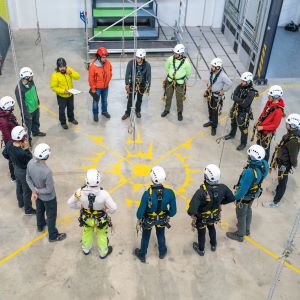How would you rate the effectiveness of your safety committee meetings on a scale of 1-10 (10 being GREAT)? If you’re normal, your average meeting ratings are around a 4 – with participants feeling drained, annoyed or frustrated.
We’ve all had the experience of “death by meeting.” There are distractions, people walk in late, someone dominates the conversation, and others are checked out or staring at their phone. And when meetings go overtime, a domino effect can completely undermine your productivity that day.
Any company can benefit from having a safety committee, but with the new MNOSHA requirement that organizations with 25 or fewer employees establish and administer regular safety committee meetings, it’s a perfect time to make them great vs mediocre!

So whether you’re in a safety committee meeting – or any other meeting – there are tips that can maximize your meeting time, so not to waste a single minute:
1. Preparation is paramount to having a successful meeting. For safety committees, we suggest a Level 10 Meeting Agenda for maximum efficiency. Send a copy of the agenda to all committee members before each meeting.
(For more information on the Level 10 Meetings, see the links at the end of this blog.)
2. Consider synchronizing your agenda with time flow. Setting times on each agenda item will help keep you focused and on track, with less wasted time and irrelevant content!
3. Ensure the right people are in the meeting. The more people who attend, the longer the meeting will go. Only include those who are absolutely essential, keeping in mind that a joint labor-management safety committee is necessary
4. Assign duties. Safety committees should have a couple key positions: 1.) A secretary to keep minutes, create the agenda and minutes accordingly, and 2.) a meeting leader to run the meeting and make sure the group stays on track – without allowing the conversation to wander.
5. Start the meeting on time and end the meeting on time.
6. Begin the meeting with a check-in that shifts the energy in the room – something like “Good News” helps the meeting start on a positive note and sets the tone for a productive session, where everyone can reset and gear up for what’s ahead.
7. Set some ground rules. Check laptops, phones and tablets at the door.
8. Ensure the technology is up and running well before the meeting begins.
9. Clearly identify and record action items, who’s accountable and by what deadline. A bad meeting is when no one is sure what, if anything, was decided or accomplished.
10. Have your committee members rate how they did as a team on a scale of 1-10. When we rate our meetings, people prepare better and engage at a higher level. It’s just human nature. What gets measured gets better!
If a meeting is rated less than a 9 or 10, ask for some feedback. The easiest way to avoid more bad meetings is to learn what’s not working and use that as fuel to manage a better meeting next time.
- Did the meeting start late?
- Was there a lack of structure?
- Was the room uncomfortable?
- Were the right people around the table?
- Was everyone an active participant?
- Did the team follow the agenda?
- Did the team create action steps with who’s accountable and by when?
- Is it time to reevaluate your meetings – daily, weekly and monthly – for their practicality? Have you accomplished the purpose of these meetings, or are you continuing to host them out of habit or ritual? How can you restructure your meetings to be more productive?
Companies running on the Entrepreneurial Operating System (EOS) follow a Level 10 Meeting Agenda, typically starting with the leadership team and rolling out through the organization. These meetings are earning “10” ratings regularly. If you’re not familiar with EOS, check out the following resources. You might be able to incorporate a couple of these tactics to enhance your reputation as a leader by improving your meetings – whether for safety committees or other meetings:
- Download the EOS Level 10 Meeting agenda
- Download chapter 1 of Traction—the book that helps you achieve effective meetings
- View the video: http://eosworldwide.com/level-10/
- Download the essential eBook on leading world-class meetings
With just a couple of adjustments and a little more structure, you can improve your safety committee meetings, coming out with clarity, focus and a feeling of accomplishment!
 763.417.9599
763.417.9599
